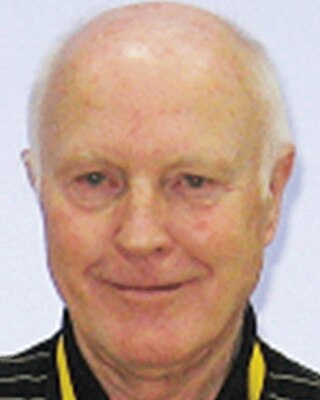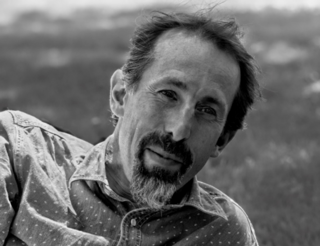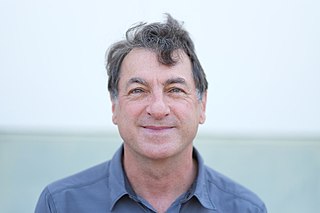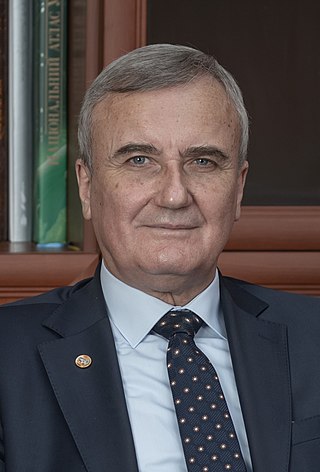
Kenneth Geddes "Ken" Wilson was an American theoretical physicist and a pioneer in leveraging computers for studying particle physics. He was awarded the 1982 Nobel Prize in Physics for his work on phase transitions—illuminating the subtle essence of phenomena like melting ice and emerging magnetism. It was embodied in his fundamental work on the renormalization group.

Seth Lloyd is a professor of mechanical engineering and physics at the Massachusetts Institute of Technology.
Nanotribology is the branch of tribology that studies friction, wear, adhesion and lubrication phenomena at the nanoscale, where atomic interactions and quantum effects are not negligible. The aim of this discipline is characterizing and modifying surfaces for both scientific and technological purposes.

Erich Sackmann is a German experimental physicist and a pioneer of biophysics in Europe.

Kam-Biu Luk is a professor of physics, with a focus on particle physics, at UC Berkeley and a senior faculty scientist in the Lawrence Berkeley National Laboratory's physics division. Luk has conducted research on neutrino oscillation and CP violation. Luk and his collaborator Yifang Wang were awarded the 2014 Panofsky Prize “for their leadership of the Daya Bay experiment, which produced the first definitive measurement of θ13 angle of the neutrino mixing matrix.” His work on neutrino oscillation also received 2016 Breakthrough Prize in Fundamental Physics shared with other teams. He also received a Doctor of Science honoris causa from the Hong Kong University of Science and Technology in 2016. Luk is a fellow of the American Physical Society, and the American Academy of Arts and Sciences.
Raymond Ethan Goldstein FRS FInstP is Schlumberger Professor of Complex Physical Systems in the Department of Applied Mathematics and Theoretical Physics (DAMTP) at the University of Cambridge and a Fellow of Churchill College, Cambridge.
Kathryn M. Zurek is an American physicist and professor of theoretical physics at the California Institute of Technology. Her research interests primarily lie at the intersection of particle physics with cosmology and particle astrophysics. She is known for her theories on dark matter's "hidden valleys", also known as hidden sectors.

Jeremy John Baumberg, is a British physicist who is Professor of Nanoscience in the Cavendish Laboratory at the University of Cambridge, a Fellow of Jesus College, Cambridge and Director of the NanoPhotonics Centre.
Shortcuts to adiabaticity (STA) are fast control protocols to drive the dynamics of system without relying on the adiabatic theorem. The concept of STA was introduced in a 2010 paper by Xi Chen et al. Their design can be achieved using a variety of techniques. A universal approach is provided by counterdiabatic driving, also known as transitionless quantum driving. Motivated by one of authors systematic study of dissipative Landau-Zener transition, the key idea was demonstrated earlier by a group of scientists from China, Greece and USA in 2000, as steering an eigenstate to destination. Counterdiabatic driving has been demonstrated in the laboratory using a time-dependent quantum oscillator.
Katherine Birgitta Whaley is a professor of chemistry at the University of California Berkeley and a senior faculty scientist in the Division of Chemical Sciences at Lawrence Berkeley National Laboratory. At UC Berkeley, Whaley is the director of the Berkeley Quantum Information and Computation Center, a member of the executive board for the Center for Quantum Coherent Science, and a member of the Kavli Energy Nanosciences Institute. At Lawrence Berkeley National Laboratory, Whaley is a member of the Quantum Algorithms Team for Chemical Sciences in the research area of resource-efficient algorithms.

Patricia Ann Thiel was an American chemist and materials scientist who served as a distinguished professor of chemistry at Iowa State University. She was known for her research on atomic-scale structures and processes on solid surfaces.

Boris Shraiman is a theoretical physicist working on statistical physics and biology. He is a Permanent Member of the Kavli Institute for Theoretical Physics and the Susan F Gurley Professor of Theoretical Physics and Biology at the University of California, Santa Barbara.

Jean-François Molinari is a French-Swiss engineer and scientist specialised in the numerical modeling of the mechanics of materials and structures. He is a full professor and the director of the Computational Solid Mechanics Laboratory at the École Polytechnique Fédérale de Lausanne (EPFL).

Mark John Bowick is a theoretical physicist in condensed matter theory and high energy physics. He is the deputy director of the Kavli Institute for Theoretical Physics at the University of California, Santa Barbara, and a Visiting Distinguished Professor of Physics in UCSB's Physics Department.

Anatoliy Hlibovych Zahorodniy is a Ukrainian theoretical physicist and an organizer of science; an academician of NANU, Vice President (2011-2020) and President of the National Academy of Sciences of Ukraine. Director of Nikolay Bogolyubov Institute of Theoretical Physics of the NAS of Ukraine. Doctor of Physical and Mathematical Sciences (1990), Professor (1998), Laureate of the State Prize of Ukraine in Science and Technology (2005), Honored Worker of Science and Technology of Ukraine (2012). He has been a Member of the National Security and Defense Council of Ukraine.
Judith A. Harrison is an American physical chemist and tribologist who is known for pioneering numerical methods that incorporate chemical reactions into modeling studies. She is a professor in the Department of Chemistry at the United States Naval Academy in Annapolis, Maryland.
Aron Pinczuk was an Argentine-American experimental condensed matter physicist who was professor of physics and professor of applied physics at Columbia University. He was known for his work on correlated electronic states in two dimensional systems using photoluminescence and resonant inelastic light scattering methods. He was a fellow of the American Physical Society, the American Association for the Advancement of Science and the American Academy of Arts and Sciences.
Eric George Adelberger is an American experimental nuclear physicist and gravitational metrologist.
Dale J. Van Harlingen is an American condensed matter physicist.
Dov I. Levine is an American-Israeli physicist, known for his research on quasicrystals, soft condensed matter physics, and statistical mechanics out of equilibrium.










